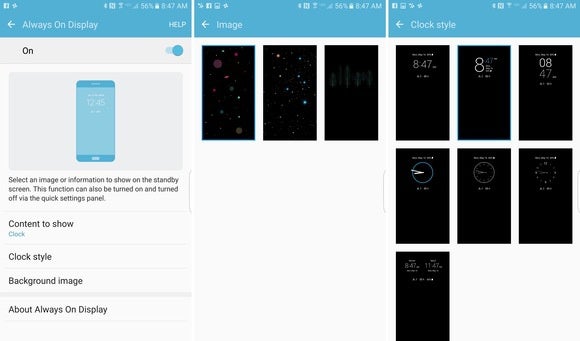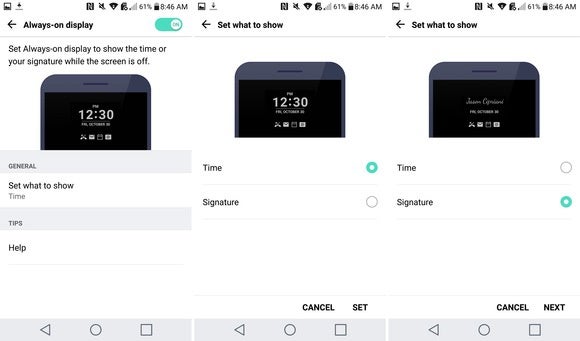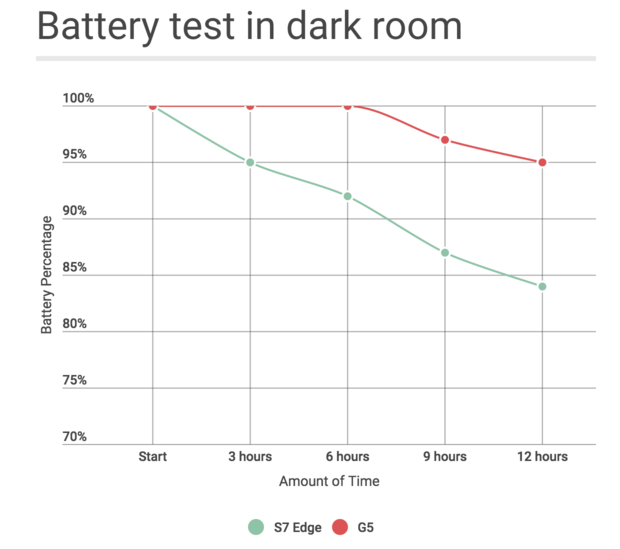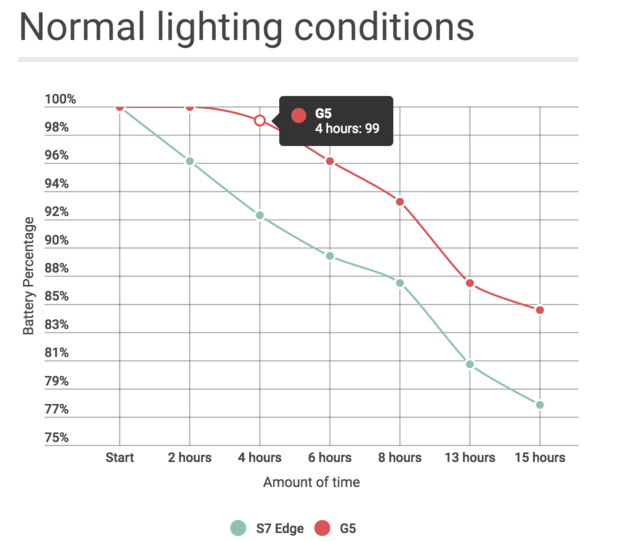The G5 Samsung Galaxy S7 line both have screens that never turn off, with each manufacturer claiming their respective solutions are optimized to use as little battery as possible.
How well does each device perform? And what features do they offer? did a little digging to find out.
Different hardware
At first glance, the two different approaches to an always-on display seem very similar. In reality, the technology powering the two different implementations is very different.
Samsung’s AMOD displays are capable or turning on a series of individual pixels, instead of lighting up a larger portion of the display as the G5’s D panel requires. In other words, if a pixel is black on the S7’s display, then that part of the screen is actually turned off.
th the G5, the top-third of the display’s backlight is turned on when the always-on display is active.
In theory, that should mean the G5’s always-on display feature will consume more energy. Does it? put the devices through a couple battery tests in an attempt to find out, but first, let’s cover each manufactures approach to always-on displays.
Galaxy S7 features

The ways-On Display settings for a Galaxy S7 ge.
Samsung’s always-on display feature offers more than just a means to check the current date, time, battery stats.
Samsung gives users the option to switch between seven different clock designs, ranging from analog to digital. Single color white schemes, to two-color blue white designs. Several patterns designs are also available to have placed behind the clock, adding some color personalization to the otherwise mundane look.
Additionally, S7 owners can opt to replace the clock with a calendar or one of three images provided by Samsung. The calendar option includes the current time, while the images are more like screen savers without any other details.
Samsung recently updated the ways-On Display app, giving users the ability to set a timeframe during the day or night when the feature is turned off. This is particularly hy for those who prefer not to have his or her phone light up a dark room late at night.
As for notifications, currently only Samsung apps are integrated with the feature. Meaning, you’ll see missed call notifications, calendar notifications, Samsung’s email app notifications on the display. You won’t see alerts from Gmail, Facebook, or any other third-party apps.
G5 features

The ways-On Display settings for an G5.
’s implementation of the G5’s always-on display is fairly basic, at least when it comes to customization. In the G5’s settings pane for the feature, you’re given few options. You can turn it on or off, choose whether you want the time or a custom string of text (which calls a “Signature”).
The G5 will constantly display the current time date, along with notification support not only for ’s core apps (like one Messaging) but for all third-party apps. en a new notification is received, a fairly large version of app’s icon replaces nearly all information displayed on the screen, is then minimized. After which, the stard layout comes back smaller app icon thumbnails fill up a row just below the current time.
Test Methodology
Both devices had the same apps services installed set up. Nearly all notifications were disabled, auto-updates in the ay Store were also disabled, auto-brightness was left enabled.
The Galaxy S7 ge had service through Verizon reless, while the G5 had an AT&T SIM.
In short, outside of the different service providers I did the best to ensure both devices were identical in set up.
After charging each device to 100%, the phones were placed on a shelf left untouched for the duration of each test—with the exception of completely waking the screen to view battery percentage. ed, battery stats are shown on the S7’s always-on display but to keep things fair I woke both devices.
Results

The G5’s always-on display seems to use less battery in a dark room.
The first test was conducted over 12 hours in a dark room. The goal of testing in a darker setting was to limit the amount of changes to the screens brightness throughout the course of a day. I checked both devices every three hours for this test.
As you can see from the chart above, the G5 used a surprisingly low 5% of battery over the course of a half day. The S7 ge, on the other h, used 18%.

In brighter light, both phones use more power for their always-on display, but the G5 still uses less.
The second test was conducted in a room with what I would consider normal lighting conditions (overhead lighting mixed with natural light during the day, with only overhead lighting at night). This was the longer of two tests, lasting 15 hours. I checked the battery every two hours, with a five hour break closer to the end of the day. The G5’s battery used three times the amount of energy in this setting than the previous test, using 15% of its total power.
The S7 ge also used more energy, but didn’t see as dramatic of an increase in power consumption as the G5 did. The S7 ge saw 22% reduction in battery power at the end of the second test, compared to an 18% drop in the first test.
Conclusion
At the end of both tests, the G5’s battery had more juice. But I’m not sure if that makes it the clear winner.
In a dark environment, the G5 barely used a measly 5% of battery over 12 hours. en looking at the results of both tests, the S7’s performance was more consistent; using only 4% more battery under normal lighting conditions than it did in a dark room.
I suspect part of the reason the G5 faired better overall despite using an D display is due to how dim its always-on display is. Often times it’s difficult to view information displayed on the G5’s always-on display in a well-lit environment. Outside of this test, I often wake the device to check the time, in turn using more battery power on the G5.
The S7’s screen will change in brightness depending on ambient light, but defaults to a brighter setting than the G5. I’ve never struggled to view the current time when glancing at the S7’s always-on screen, no matter the ambient lighting.
So what does this all mean? Both manufacturers have figured out a way to implement a feature that provides useful information at a glance, without wreaking havoc on battery life. Still, you’re going to take a bit of a hit on battery life in exchange for a screen that’s always on.
















